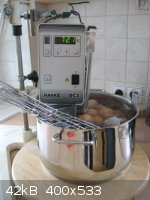garage chemist
chemical wizard
    
Posts: 1803
Registered: 16-8-2004
Location: Germany
Member Is Offline
Mood: No Mood
|
|
Easter eggs sous-vide
Sous-vide is a method of cooking in which meat or other food products are sealed into plastic bags and cooked at a precisely controlled temperature in
a water bath for a relatively long time, often several hours.
It can also be used for giving egg yolks a special consistency, as shown here:
http://blog.khymos.org/2011/04/23/perfect-egg-yolks-part-2/
Another application is making Onsen eggs, a japanese speciality where eggs are slow-cooked for over an hour at about 64°C, resulting in a mushy egg
white and firm, but still soft yolk:
http://norecipes.com/blog/onsen-tamago-hot-spring-egg/
I have an accurate electronic water bath thermostat that is mostly reserved to kitchen use and has been used successfully for sous-vide cooking of
meat, the result being juicier than with any other method.
This time, the aim was to make perfect hard-boiled eggs in which the yolk is still relatively soft and not crumbly.
In the attached picture you can see the setup: a large cooking pot with the thermostat suspended from a rotovap lab stand.
The recirculating pump of the thermostat is so strong that the eggs have to be restrained from moving around with metal grids, it's almost like a
whirlpool in the pot.
The first try was 45 minutes at 72°C. This resulted in a typical Onsen egg: yolk perfectly done and soft, but the white still very soft and mushy. It
is clear from this observation that the yolk coagulates at a lower temperature than the white if the cooking time is this long.
The second try was 45 minutes at 80°C. This was too hot: the yolk was firm and crumbly, like in a typical hardboiled egg, while the egg white was
still softer than desired.
The third try was then chosen at 30 minutes and 70°C, and directly afterwards the eggs were placed in boiling water for exactly 2 minutes to set the
egg white, and then cooled in cold water. This finally gave the perfect easter eggs, which were then colored.

[Edited on 6-4-2012 by garage chemist]
|
|
|
DougTheMapper
Hazard to Others
  
Posts: 145
Registered: 20-7-2008
Location: Michigan, USA
Member Is Offline
Mood: Energetic
|
|
I'm coming to your house for Easter. Well done!
Victor Grignard is a methylated spirit.
|
|
|
Formatik
National Hazard
   
Posts: 927
Registered: 25-3-2008
Member Is Offline
Mood: equilibrium
|
|
A fine application of molecular gastronomy. Some of those eggs seen on that page remind me of Fondant-Eier.
|
|
|